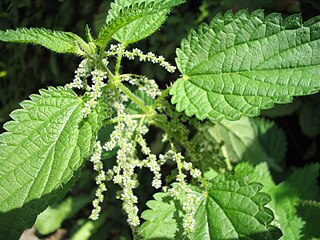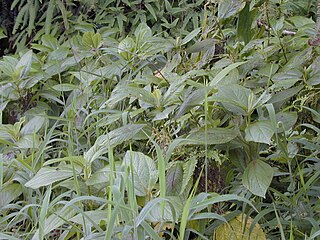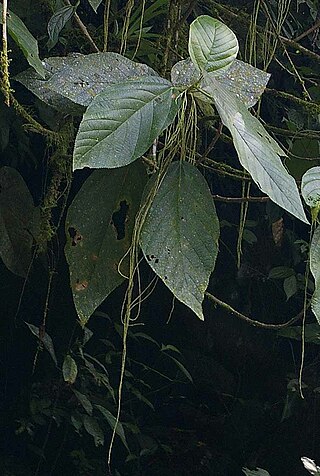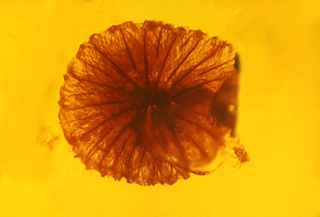
The Urticaceae are a family, the nettle family, of flowering plants. The family name comes from the genus Urtica. The Urticaceae include a number of well-known and useful plants, including nettles in the genus Urtica, ramie, māmaki, and ajlai.

George O. Poinar Jr. is an American entomologist and writer. He is known for popularizing the idea of extracting DNA from insects fossilized in amber, an idea which received widespread attention when adapted by Michael Crichton for the book and movie Jurassic Park.

Boehmeria is a genus of 47 species of flowering plants in the nettle family Urticaceae. Of the species, 33 are indigenous to the Old World and 14 to the New World; no species is indigenous to both the Old and New Worlds. The species include herbaceous perennials, shrubs and small trees. Although related to the similar-looking species of the stinging nettles of genus Urtica, species of Boehmeria do not have stinging hairs. Because of the similarity in appearance, some species are commonly called "false nettles".

Dominican amber is amber from the Dominican Republic derived from resin of the extinct tree Hymenaea protera.

Myriocarpa is a genus woody plant which ranges in size from shrubs to small trees and is endemic to Central and South America. Within the Urticaceae, Myriocarpa is characterized by long pendulous string-like female inflorescences of apparently naked flowers and stems which release a watery latex when cut. Estimates for the diversity of the genus range from five to eighteen species. Research for Flora Mesoamericana indicates that there are probably fifteen to twenty species.

Coprinites is an extinct monotypic genus of gilled fungus in the Agaricales family Agaricaceae. At present it contains the single species Coprinites dominicana.

Paleoleishmania is an extinct genus of kinetoplastids, a monophyletic group of unicellular parasitic flagellate protozoa. At present it is placed in the family Trypanosomatidae. The genus contains two species, the type species Paleoleishmania proterus and the later described Paleoleishmania neotropicum.

Vetufebrus is an extinct genus of haemospororida in the family Plasmodiidae. At the time of its description the new genus comprised a single species Vetufebrus ovatus known from a single Miocene Dominican amber fossil found on Hispaniola. V. ovatus was vectored by Enischnomyia stegosoma, the first fossil streblid bat fly described from a fossil, and the only member of the subfamily Nycterophiliinae described from Hispaniola. V. ovatus is the first instance of a Streblidae bat fly as a host for a malarial parasite.
Termitaradus dominicanus is an extinct species of termite bug in the family Termitaphididae known from a Miocene fossil found on Hispaniola. T. dominicanus is the third species in the genus Termitaradus to have been described from fossils found in Dominican amber after Termitaradus avitinquilinus and Termitaradus mitnicki.
Termitaradus protera is an extinct species of termite bug in the family Termitaphididae known from several Late Oligocene to Early Miocene fossils found in Mexico. T. protera is the only species in the extant genus Termitaradus to have been described from fossils found in Mexican amber and is one of four species from new world amber; the others are Termitaradus avitinquilinus, Termitaradus dominicanus and Termitaradus mitnicki. T. protera was also the first termite bug described from the fossil record.
Hymenaea mexicana is an extinct legume species in the family Fabaceae described from a series of isolated fossil petals, leaflets, and amber. The species is known from a group of Late Oligocene to Early Miocene locations in southern Mexico. It is one of two extinct Hymenaea species placed close to the living species Hymenaea verrucosa and along with Hymenaea allendis, is one of the two extinct species which have been found in Mexican amber.
Acanthognathus poinari is an extinct species of ant in the subfamily Myrmicinae known from a single possibly Miocene fossil found on Hispaniola. A. poinari is the first species of the ant genus Acanthognathus to have been described from fossils found in Dominican amber and is one of several species of Acanthognathus found in the Greater Antillas.
Pollen beetle is an informal term for any species of beetle associated intimately with suitably pollen-rich species of flowers. Typically such a beetle is adapted to the pollen as a major part of its diet. Species in at least sixteen families of the order Coleoptera could be counted as pollen beetles, and "pollen beetle" also is a common name for some such species.

Formicodiplogaster is an extinct form genus of nematodes in the family Diplogasteridae which currently includes a single described species Formicodiplogaster myrmenema. The species is known from early Miocene fossils found on Hispaniola. F. myrmenema has been preserved in association with Azteca alpha, one of only two known fossil species in the ant genus Azteca.

Azteca alpha is an extinct species of ant in the subfamily Dolichoderinae known from possibly Miocene fossils found on Hispaniola. A. alpha is one of only two species in the genus Azteca to have been described from fossils, both found in Dominican amber. It is the host for a fossil nematode, and has been preserved with scale insects.
Feroseta is an extinct genus of mantidfly in the neuropteran family Mantispidae known from a fossil found in North America, and which contains a single species, Feroseta prisca.
This article contains papers in paleobotany that were published in 2016.
Ekrixanthera ehecatli is a species of extinct plant first described from fossilised flowers from Mexican amber. Its flowers lack pedicels and are pentamerous and staminate; they have a pistillode with reduced pilosity; glabrous heteromorphic tepals with truncate tips. Differentiating it from Ekrixanthera hispaniolae are the presence or absence of a pedicel, the heterotrophic tepals, and the presence or absence of pilosity of its pistillode and tepals. Additionally, the latter characters added to the pentamerous flowers separate the two fossil species from extant genera. Its floral structures indicate an explosive manner of pollen release as well as anemophily. Lepidopterans feeding on this species is suspected during the mid-Tertiary.
Ekrixanthera hispaniolae is a species of extinct plant first described from fossilised flowers from Dominican amber. It has staminate flowers on short pedicels that are pentamerous, with a pilose pistillode, plus heteromorphic pilose tepals. Differentiating it from Ekrixanthera ehecatli are the presence or absence of a pedicel, the heterotrophic tepals, and the presence or absence of pilosity of its pistillode and tepals. Additionally, the latter characters added to the pentamerous flowers separate the two fossil species from extant genera. Its floral structures indicate an explosive manner of pollen release as well as anemophily. Lepidopterans feeding on this species is suspected during the mid-Tertiary.
This article records new taxa of plants that are scheduled to be described during the year 2017, as well as other significant discoveries and events related to paleobotany that are scheduled to occur in the year 2017.









